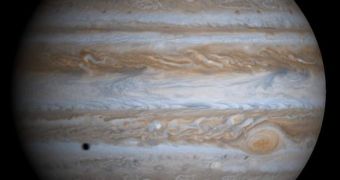Experts at the NASA Jet Propulsion Laboratory (JPL), who managed the NASA Cassini orbiter around Saturn, are proud to announce that today is the ten-year anniversary of the moment when the spacecraft passed by Jupiter, on its way to its final target.
The encounter took place on December 30, 2000, as Cassini was heading for a July 1, 2004 orbital insertion maneuver that would see it captured around Saturn. During the Jovian flyby, the prove snapped some amazing photos of the gas giant.
One of the reasons why the spacecraft flew past Jupiter was to use the planet to produce the renowned “slingshot effect,” a gravity-assist maneuver that uses a space body's gravity to change the speed and orientation of probes as they travel through the solar system.
There were numerous advantages to passing by Jupiter on the way to Saturn, in addition to navigation assistance. During the maneuver, Cassini mission control had a chance to test all of the scientific instruments aboard the probe.
An evaluation of the operations plans created for Saturnine observations was also conducted at the time, and the wealth of data experts collected was of great importance later on in the mission.
“The Jupiter flyby allowed the Cassini spacecraft to stretch its wings, rehearsing for its prime time show, orbiting Saturn,” explains JPL Cassini project scientist Linda Spilker.
“Ten years later, findings from the Jupiter flyby still continue to shape our understanding of similar processes in the Saturn system,” the expert goes on to say.
Jupiter was explored non-stop between October 2000 and March 2001, before Cassini departed the largest planet in our solar system for its final destination. During the flyby, the probe got within 9.7 million kilometers (6 million miles) of Jupiter at its point of closest approach.
This maneuver brought the spacecraft closest to the Jovian cloud tops at 10:05 am UTC on December 30, 2000. During its investigations, the probe collected about 26,000 images of Jupiter and its moons.
In turn, this allowed experts to create the most detailed global ma of Jupiter available to date. In this way, Cassini managed to boost our understanding of not one, but two gas giants in the solar system.
“The imaging team was also able to amass 70-day movies of storms forming, merging and moving near Jupiter's north pole,” the JPL team says.
“Cassini's composite infrared spectrometer was [also] able to do the first thorough mapping of Jupiter's temperature and atmospheric composition,” experts at the Lab add.
“The Jupiter flyby benefited us in two ways, one being the unique science data we collected and the other the knowledge we gained about how to effectively operate this complex machine,” Bob Mitchell explains.
“Today, 10 years later, our operations are still heavily influenced by that experience and it is serving us very well,” concluded the JPL Cassini program manager.
The Cassini-Huygens mission is a cooperative project of NASA, the European Space Agency and the Italian Space Agency. JPL, a division of the California Institute of Technology (Caltech), manages the mission for NASA's Science Mission Directorate, Washington DC.
The Cassini orbiter and its two onboard cameras were designed, developed and assembled at JPL. The imaging team is based at the Space Science Institute in Boulder, Colorado.
The composite infrared spectrometer team is based at NASA's Goddard Space Flight Center, in Greenbelt, Maryland, where the instrument was built.
The radio and plasma wave science team is based at the University of Iowa in Iowa City, where the instrument was built.

 14 DAY TRIAL //
14 DAY TRIAL //